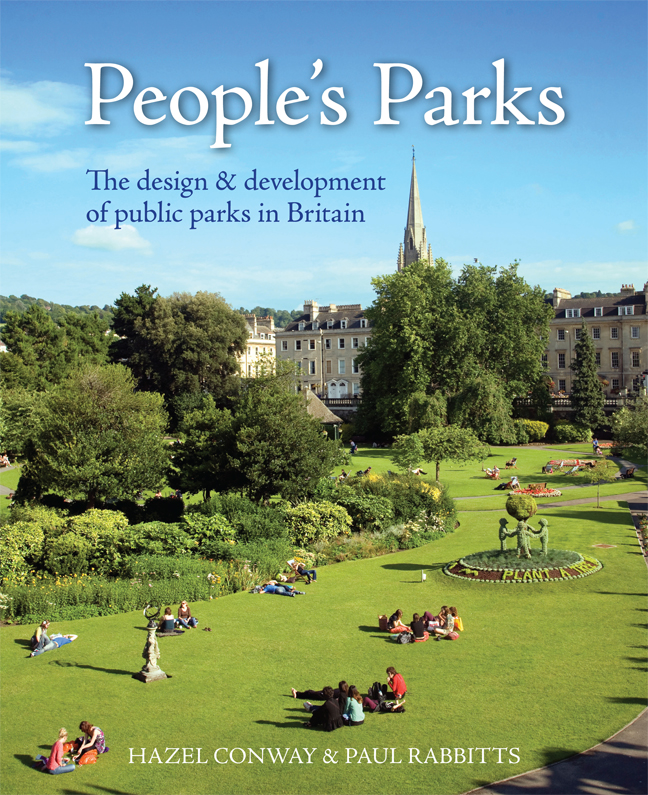Book contents
- Frontmatter
- Dedication
- Contents
- Miscellaneous Frontmatter
- Preface
- Acknowledgements
- Foreword
- A Word from Parks Professionals, Politicians and Parks Organisations
- Introduction: Dr Hazel Conway (1991)
- 1 Public Parks and Municipal Parks
- 2 The Need for Parks
- 3 Pioneering Parks Development
- 4 The Park Movement
- 5 Design and Designers
- 6 Lodges, Bandstands and the Cultivation of Virtue
- 7 Local Pride and Patriotism
- 8 Planting and Park Maintenance
- 9 Permitted Pastimes
- 10 Recreation Grounds, Parks and the Urban Environment
- 11 Public Parks, 1885–1914
- 12 Later Municipal Park Designers
- 13 Garden Cities and the New Towns Movement
- 14 Sport, Physical Activity and Recreation in Public Parks in the Inter-war Years
- 15 Parks Management – a Changing Perspective
- 16 Decline, Revival and Renewal – the Role of Parks into 21st-century Britain
- Appendix 1 Summary of main legislation promoting early park development
- Appendix 2 Chronology of main municipal and public park developments between 1800 and 1885
- Notes
- Bibliography
- Subscription List
- Index
2 - The Need for Parks
Published online by Cambridge University Press: 22 February 2024
- Frontmatter
- Dedication
- Contents
- Miscellaneous Frontmatter
- Preface
- Acknowledgements
- Foreword
- A Word from Parks Professionals, Politicians and Parks Organisations
- Introduction: Dr Hazel Conway (1991)
- 1 Public Parks and Municipal Parks
- 2 The Need for Parks
- 3 Pioneering Parks Development
- 4 The Park Movement
- 5 Design and Designers
- 6 Lodges, Bandstands and the Cultivation of Virtue
- 7 Local Pride and Patriotism
- 8 Planting and Park Maintenance
- 9 Permitted Pastimes
- 10 Recreation Grounds, Parks and the Urban Environment
- 11 Public Parks, 1885–1914
- 12 Later Municipal Park Designers
- 13 Garden Cities and the New Towns Movement
- 14 Sport, Physical Activity and Recreation in Public Parks in the Inter-war Years
- 15 Parks Management – a Changing Perspective
- 16 Decline, Revival and Renewal – the Role of Parks into 21st-century Britain
- Appendix 1 Summary of main legislation promoting early park development
- Appendix 2 Chronology of main municipal and public park developments between 1800 and 1885
- Notes
- Bibliography
- Subscription List
- Index
Summary
The aim of the Report of the Select Committee on Public Walks (SCPW), 1831, was to establish what open space was available for public use in the major towns and to recommend local and national action to ensure adequate provision in the future. Although economic factors had provided the main impetus for the development of the early 19th-century parks, they were not stressed in the report. Its main emphasis was on the physical need for open space and the ‘problem’ of working-class recreation. The report was chaired by R A Slaney and it was the only one, of all those produced during the century, to focus solely on public walks. Slaney's contribution to the promotion of parks was probably one of the most sustained and effective of all those who were working in this area. Not only did he bring the problem to Parliament's attention in 1833, but some 25 years later he was also responsible for promoting the Recreation Grounds Act 1859, an important piece of legislation aimed at stimulating the provision of parks. Slaney had entered Parliament in 1826 as Member for Shrewsbury and had earlier given some indication of where his interests lay in An Essay on the Beneficial Direction of Rural Expenditure. This included sections on places of amusement ‘for the labouring classes’, and on the advantages of public walks and gardens, but was directed at rural rather than urban conditions.
The physical need
Until towns had grown considerably there was little physical need to set aside open space specifically for recreation. The existing open spaces of the town square, the marketplace and the churchyards remained from medieval times, and most towns were small enough for adjacent spaces such as commons and wasteland to be accessible. In the mid-18th century, approximately one person in five lived in a town of any size, and the population of England and Wales was of the order of six million. By the beginning of the 19th century London was the largest city, with a population of over one million, and other urban centres were growing rapidly. Manchester, Liverpool, Birmingham and Bristol all had, by 1801, populations of over 60,000. Fifty years later the figures for Manchester and Liverpool had reached nearly 400,000, Birmingham was well over 200,000, and 1851 marks the point when the population became equally divided between town and country dwellers (Table 2.1).
- Type
- Chapter
- Information
- People's ParksThe design & development of public parks in Britain, pp. 7 - 18Publisher: Boydell & BrewerPrint publication year: 2023



